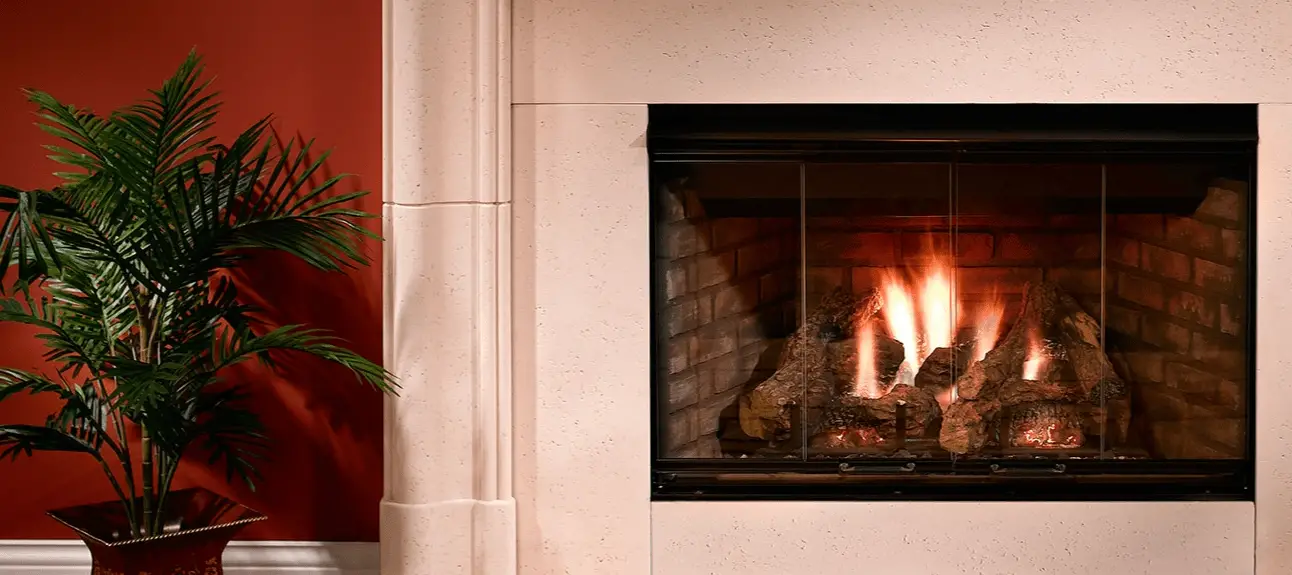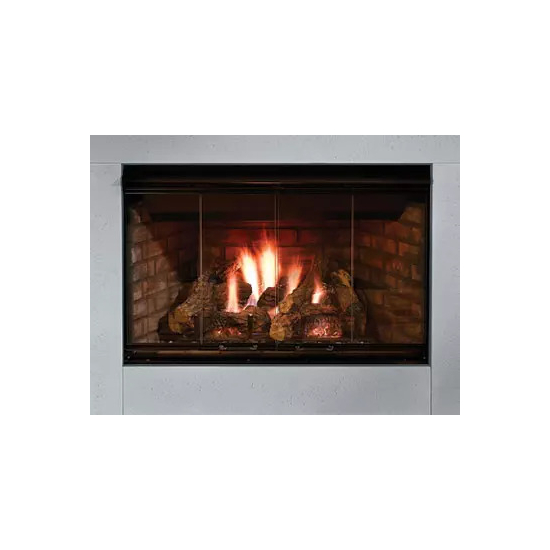Gas fireplaces require venting to release combustion gases outside the home for safety and air quality reasons. Ventless gas fireplaces are designed to burn cleanly and efficiently by mixing gas and air without producing harmful fumes like their vented counterparts.
These models operate similarly to a gas range in the kitchen, providing a comfortable living environment without needing a traditional chimney or flue. However, without proper ventilation, ventless fireplaces can pose health risks due to the emission of nitrous dioxide and carbon monoxide.
Several states, including Massachusetts and California, have even prohibited the use of ventless gas fireplaces to safeguard residents from potential dangers. It is crucial to have the appropriate venting system in place to ensure safe and effective operation of gas fireplaces.


Credit: www.fireplacedoorsonline.com
- Understanding Ventless And Vented Gas Fireplaces
- Do Gas Fireplaces Need To Be Vented?
- Pros And Cons Of Ventless Gas Fireplaces
- Regulations And Banning Of Ventless Gas Fireplaces
- Choosing Between Ventless And Vented Gas Fireplaces
- Frequently Asked Questions Of Do Gas Fireplaces Need To Be Vented
- Conclusion
Understanding Ventless And Vented Gas Fireplaces
In the realm of gas fireplaces, there are two primary types to consider: ventless and vented fireplaces. Understanding the differences between these options and the associated safety concerns is crucial for making an informed decision for your home.
Differences Between Ventless And Vented Fireplaces
When comparing ventless and vented gas fireplaces, the key distinction lies in their need for a ventilation system. Vented fireplaces require a chimney or flue to expel combustion byproducts outside, while ventless fireplaces operate without the need for external ventilation.
Safety Concerns With Ventless Fireplaces
While ventless gas fireplaces offer convenience, there are important safety considerations to keep in mind. Due to the lack of a venting system, there is a risk of indoor air quality issues, including the buildup of carbon monoxide and other harmful gases.
To mitigate these safety concerns, regular maintenance and proper ventilation of the space are essential when utilizing a ventless gas fireplace. It is imperative to follow manufacturer guidelines and have the unit inspected by a professional to ensure safe operation.
Do Gas Fireplaces Need To Be Vented?
Proper ventilation is crucial for gas fireplaces to operate safely and efficiently. Without adequate venting, harmful gases like carbon monoxide can accumulate, posing serious health risks to anyone in the vicinity.
- Smoke blowing back into the room
- Chimney blockages
- Negative pressure causing backdrafting
- Inadequate firebox size
These signs indicate potential venting problems that need immediate attention to ensure the gas fireplace functions properly.
Pros And Cons Of Ventless Gas Fireplaces
Ventless gas fireplaces offer a range of benefits and drawbacks that should be carefully considered before making a decision. In particular, it’s important to weigh the flexibility in installation locations against the potential drawbacks of ventless fireplaces.
Flexibility In Installation Locations
One of the primary advantages of ventless gas fireplaces is the flexibility they offer in terms of installation locations. Because they do not require a chimney or vent, they can be installed virtually anywhere in a home, including in rooms where traditional vented fireplaces would be impractical or impossible to accommodate. This makes them an attractive option for homeowners who want the ambiance of a fireplace without the limitations of vented systems.
Drawbacks Of Ventless Fireplaces
Despite their flexibility, ventless gas fireplaces also come with several drawbacks that must be taken into consideration. One of the primary concerns is the potential for indoor air quality issues, as ventless fireplaces release combustion byproducts, such as carbon monoxide and nitrogen dioxide, directly into the living space. This can pose health risks if the fireplace is not properly maintained or if it is used in a poorly ventilated area.
Moreover, some regions have regulations or bans on the use of ventless gas fireplaces due to safety concerns, meaning homeowners may be limited in their options based on their location. Additionally, because ventless fireplaces rely on using oxygen from the room for combustion, they can lead to increased humidity levels and the potential for moisture-related issues in the home.

Credit: blackswanhome.com
Regulations And Banning Of Ventless Gas Fireplaces
Regulations and Banning of Ventless Gas Fireplaces have been implemented in several states due to safety concerns. Ventless gas fireplaces don’t require venting, but they can produce harmful gases like carbon monoxide if not properly maintained or operated. It’s essential to follow the regulations and have your gas fireplace inspected regularly to ensure safety.
States And Countries With Bans
In an effort to prioritize safety, several states in the U.S. and countries worldwide have implemented regulations and bans on ventless gas fireplaces. Notable states that have prohibited the use of ventless gas fireplaces include Massachusetts, California, and others. These bans are in place due to the potential safety concerns associated with burning gas in a ventless environment. Additionally, countries such as Canada have also outlawed the use of ventless gas fireplaces. It is important to be aware of these regulations and bans before considering the installation of a ventless gas fireplace.Reasons For Prohibition
The prohibition of ventless gas fireplaces is primarily driven by safety concerns. These fireplaces do not require a chimney or external venting system, which means that all combustion byproducts are released directly into the living space. This lack of ventilation can lead to a buildup of harmful gases, such as carbon monoxide and nitrous dioxide. Exposure to these gases can have serious health implications, including carbon monoxide poisoning. As a result, states and countries have opted to prohibit the use of ventless gas fireplaces to protect the well-being of individuals and households. It is crucial to note that these safety concerns extend beyond the immediate occupants of the space. In multi-unit buildings, the use of ventless gas fireplaces can pose a risk to neighboring units as well. The potential for gas leaks and the release of toxic fumes makes it imperative to adhere to regulations and bans. To ensure the safe operation of gas fireplaces, venting systems such as direct vent and natural vent options are encouraged. These systems effectively remove combustion byproducts and promote proper airflow, minimizing the risk of harmful gas buildup. In conclusion, maintaining safety standards is paramount when it comes to heating appliances like gas fireplaces. Regulations and bans on ventless gas fireplaces have been implemented in various states and countries due to the potential harm they can pose. Prioritizing the well-being of individuals and communities, it is essential to adhere to these regulations and choose vented options that mitigate the risk of gas-related hazards. By doing so, homeowners can enjoy the benefits of a warm and cozy atmosphere without compromising on safety.Choosing Between Ventless And Vented Gas Fireplaces
When it comes to gas fireplaces, one of the crucial decisions homeowners have to make is whether to choose a ventless or vented option. Each type has its own set of advantages and considerations, and it’s important to understand these factors before making a final decision. In this article, we will explore the key considerations for selecting the right type of gas fireplace and provide professional recommendations to help you make an informed choice.
Considerations For Selecting The Right Type
Choosing between ventless and vented gas fireplaces requires careful consideration of several factors. Here are the key points to keep in mind:
- Heating Efficiency: Ventless gas fireplaces are known for their high heating efficiency. They burn cleaner and more efficiently, making them an excellent choice for homeowners looking to save on energy costs.
- Air Quality: While vented gas fireplaces safely expel combustion gases through a chimney or vent, ventless models release exhaust fumes directly into the room. This can affect indoor air quality and may not be suitable for individuals with respiratory issues or allergies.
- Installation Flexibility: Ventless gas fireplaces offer greater installation flexibility since they don’t require an external chimney or vent. This makes them ideal for homes without existing flues or for those looking for a hassle-free installation process.
- Local Regulations: It’s essential to check your local building codes and regulations to determine if ventless gas fireplaces are permitted in your area. Some states or municipalities have restrictions on their use due to safety concerns.
Professional Recommendations
When it comes to choosing between ventless and vented gas fireplaces, it’s always a good idea to consult with a professional. They can provide expert advice tailored to your specific needs and circumstances. Here are some professional recommendations to consider:
- Get a Professional Assessment: Have a licensed technician assess your home’s ventilation system and determine the feasibility of installing a vented gas fireplace. They can also advise on proper sizing to ensure optimal performance.
- Weigh the Pros and Cons: Consider the advantages and disadvantages of ventless and vented gas fireplaces based on your heating needs, air quality concerns, and local regulations.
- Consider Energy Efficiency: If energy efficiency is a priority for you, a ventless gas fireplace may be the preferred choice due to its higher heating efficiency and lower energy consumption.
- Ensure Proper Ventilation: If you opt for a vented gas fireplace, ensure that your home has adequate ventilation to accommodate the necessary chimney or vent installation.
By taking these considerations into account and seeking professional guidance, you can confidently select the right type of gas fireplace that best suits your home and personal preferences. Whether you choose a ventless or vented option, a gas fireplace can enhance the ambiance and warmth of your living space.

Credit: fireplacesusa.com
Frequently Asked Questions Of Do Gas Fireplaces Need To Be Vented
Can You Have A Gas Fireplace Without A Vent?
A ventless gas fireplace is possible and efficient, burning gas cleanly without venting exhaust fumes.
What Happens If You Don’t Vent A Gas Fireplace?
Not venting a gas fireplace can lead to dangerous health risks from nitrous dioxide and carbon monoxide buildup.
What States Have Banned Ventless Gas Fireplaces?
Massachusetts, California, and other states in the U. S. have banned ventless gas fireplaces due to safety concerns.
How Do I Know If My Gas Fireplace Needs To Be Vented?
A vented gas fireplace is important for proper ventilation and safety. Signs of venting issues include smoke blowing back into the room and chimney blockages. A ventless gas fireplace may seem convenient, but it can produce harmful gases like nitrous dioxide and carbon monoxide.
Some states have even banned ventless gas fireplaces due to safety concerns. It’s crucial to have a properly vented gas fireplace to avoid health risks.
Can You Have A Gas Fireplace Without A Vent?
A ventless gas fireplace makes it easy to live in comfort! It burns efficiently and eliminates exhaust fumes, working similarly to a kitchen gas range.
Conclusion
When considering gas fireplaces, proper ventilation is crucial for safety and efficiency. Ventless options may seem convenient, but they come with potential health hazards. Always consult with a professional to ensure the proper setup and maintenance of your gas fireplace.
Prioritizing safety ensures that you can enjoy the warmth and comfort without compromising your well-being.